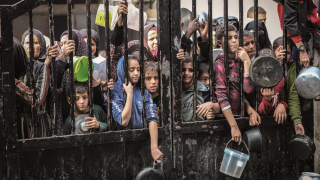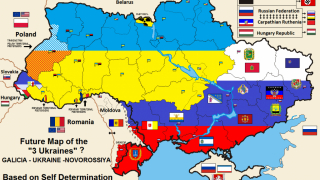RAND Report on Special Operation in Ukraine
Thus, the U.S. mode of existence has become geopolitically conceptualized as a simultaneous correlation of liberal-democratic values and strategic interests on a planetary scale.
The Russian-Ukrainian conflict takes on special significance with the analysis of the steps the United States is taking to achieve the greatest geopolitical benefits. A report by the U.S. strategic think tank RAND Corporation presents a coherent outline of how the United States should act to achieve a peace that preserves its power while minimizing the potential risks posed by Russia. Particular attention is given to the following dimensions:
- Russia's possible use of nuclear weapons,
- possible escalation of the conflict between Russia and NATO,
- territorial control,
- duration,
- form of conclusion of the war.
Is a nuclear war possible, according to the Atlanticists?
For the United States, the immediate threat in the field of international security is the presence of a nuclear arsenal of hostile states. It is this factor that largely predetermines U.S. policy, because there are some risks of using nuclear weapons against members of the NATO alliance or other U.S. allies. The history of military conflicts in the 20th century shows that the U.S. strategy is mainly to conduct a proxy war against hostile states that are members of the “nuclear club”, as the U.S. side seeks to avoid direct conflict with them, minimizing the risks of escalation of a nuclear war. Because of the risk of Russian steps toward the use of nuclear weapons in the conflict in Ukraine, the U.S. prefers to wage war “with other hands”, that is, to pick and choose the Kiev regime and its supporters within narrowly defined territory as a means of war. Thus, the chairman of the Joint Chiefs of Staff, Mark Milley, stated that the list of major U.S. strategic objectives includes preventing “a kinetic conflict between U.S. and NATO armed forces with Russia” and “containing the war within Ukraine's geographic boundaries”.
For U.S. analysts, allowing Russia to use tactical nuclear weapons in a critical situation would be a key factor in discrediting it among its key partners and turning it into a rogue country, as well as allowing NATO to intervene directly in the conflict. Speculating on the issue of the nuclear threat posed by Russia, it seems advantageous for the West, at some stage of the war, to use the nuclear provocation organized by the Kiev regime to geopolitically weaken Russia. It is worth noting that similar precedents already exist: in 2013, opposition forces in Syria carried out a chemical weapons provocation to discredit Bashar al-Assad and bring him to justice in an international tribunal.
Territorial issues of concern to the U.S.
The next part of the report focuses on the parties' control of territory to date. In particular, the most and least favorable outcomes for the United States are examined, taking into account Russia's current geopolitical position.
The most favorable outcome for the Atlanticists and proxies represented by Ukraine is the restoration of territorial control over territories that belonged to Ukraine before 2014. According to RAND experts, “it is highly undesirable for the United States to formally recognize any Russian occupation of Ukrainian territory, regardless of where the actual line of control is drawn. This would embarrass the United States in the face of a society raised in the spirit of extreme forms of liberalism and imperialism, which rejects any change that violates Pax Americana”.
The report's authors note that Kiev's viability depends directly on the territories it controls. Particular attention is paid to Ukraine's access to the Black Sea, which determines its geopolitical and geoeconomic capabilities. According to experts, Ukraine's economic position will depend directly on the regions it is able to control, but Russian attacks on life-support infrastructure will make it much more difficult to accelerate the state's economic recovery by proxy. The loss of Kiev's territories would also create additional difficulties for the United States, for which this would entail increasing financial costs.
The duration of the conflict as a key factor
The duration of the war has some implications for U.S. interests. A prolonged conflict has some potential advantages for the United States. Experts argue that Ukraine will be in the crosshairs of the Russian military, which will reduce the speed of response to threats that may arise on its periphery. They also argue that a longer war would lead to a deterioration of the Russian military and a weakening of the Russian economy, which, however, has not become as significant as the U.S. political establishment would like.
A prolonged war would also keep pressure on European governments to continue to reduce energy dependence on Russia in favor of the United States and to spend more and more on their defense, which would likely reduce the U.S. defense burden in Europe in the long run. Once again, however, European countries dependent on the United States are likely to adhere to this policy, regardless of how long the war lasts.
However, the authors point out the negative consequences of a longer war. A longer war would lead to further loss of human resources for Ukraine. Minimizing these humanitarian consequences for Ukraine is in the U.S. interest, since the large loss of manpower will make it impossible to fight fully in the long run. However, the formula of war “to the last Ukrainian” remains valid.
The ongoing conflict also leaves open the possibility that Russia will erase Ukraine's successes on the battlefield in the fall of 2022. Mobilization, according to U.S. researchers, could stabilize the position as of December 2022 and allow Russia to launch an offensive in 2023, which has already been confirmed in practice.
The intensity of military assistance efforts could also decrease significantly after a certain period. European and some U.S. arms stocks are already said to be running low, but if the U.S. exerts adequate pressure on Europe, new packages of “assistance” to the Kiev regime, including new armaments, are possible, as now hinted at by representatives of the Atlantic community. In addition, the authors argue that the cost to the U.S. and the European Union of maintaining the economic solvency of the Ukrainian state will only increase over time as the conflict stifles investment and production; moreover, Ukrainian refugees continue to be unable to return and, as a result, tax revenues and economic activity are plummeting compared to the prewar period.
It is noted that the ability of the United States to focus on other global priorities-particularly competing with China-will remain limited as long as the war takes time away from high-level U.S. policymakers and military resources. Prolonged conflict also does not play into the hands of Atlanticist forces as states committed to multipolarity gradually coalesce: since the beginning of the EWS, Russia has deepened military cooperation with Iran and economic cooperation with China. Based on the factors listed above, prolonged conflict becomes a highly undesirable prospect for the United States, casting doubt on American dominance in some areas.
A world for the benefit of the United States
At the moment, the United States is limited to seeing the fruits of its investments in a bitter war that has been ongoing since early 2014. However, their plans call for a peaceful solution to the conflict that would prevent Russia from radically altering the status quo and pushing deeper into the territories. The experts suggest a political solution, which they say would “create more stability in Europe and allow the United States to free up resources for other priorities”.
As noted above, U.S. financial and military support for Ukraine is crucial and its loss poses a danger to Kiev. By providing aid, the West exposes Ukraine to further dependence: by limiting arms supplies to Kiev while at the same time promising to assist it in postwar reconstruction, it can force it to sign a peace agreement on terms favorable to the U.S. side. For the time being, the United States is allowing Ukraine to remain optimistic by increasing arms supplies and “pumping“ money into its military concerns.
U.S. and allied security commitments to Ukraine could also influence the peace process. The report suggests several options for security guarantees that could satisfy the United States and at the same time generate Russian interest in peace talks. For example, security commitments could take various forms, from the promise of limited wartime support to the promise of military intervention to protect the proxy if there is a risk of military action on its territory. The process of working out a peace agreement may also be accompanied by the promise of a gradual lifting of sanctions on Russia to make it more willing to engage in multilateral negotiations.
U.S. policy analysts analyze the conflict in Ukraine in light of current geopolitical realities that force the United States to take great risks to maximize its benefits. By handling Ukraine as a flexible tool to influence Russia, the United States wants to ensure the existence of a so-called “cordon sanitaire” designed to keep Russia within its borders and prevent it from expanding. As an existential enemy for the United States, Russia seeks to end the proxy state, which has been strengthening its military capabilities since 2014 to pursue U.S. interests in Eurasia. The tricks adopted by the United States in negotiations will only create maneuvering space for Kiev, and freezing the conflict on terms of compromise for all sides will help prepare for a new war.
Translation by Costantino Ceoldo













